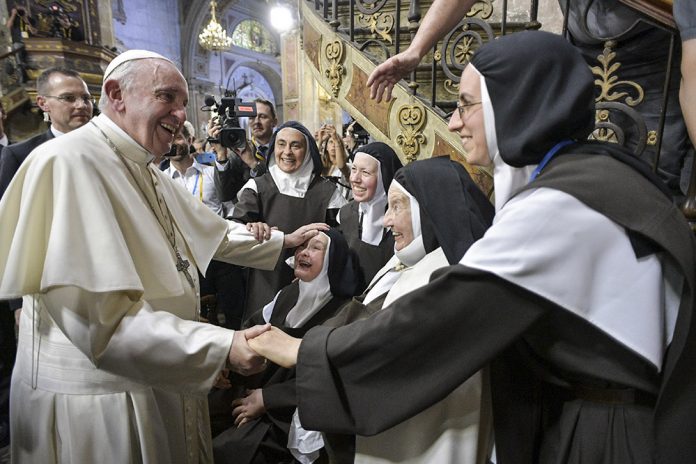
Question: Can you help me understand — and explain to my middle schoolers — why a religious sister is called a bride of Christ? And how is this different from the Church itself being the Bride of Christ?
— Anonymous
SR. BRITTANY HARRISON REPLIES …
You ask a very good question. Regarding nuns, the Catechism of the Catholic Church says, Virgins who, committed to the holy plan of following Christ more closely, are consecrated to God by the diocesan bishop according to the approved liturgical rite, are betrothed mystically to Christ, the Son of God, and are dedicated to the service of the Church.” By this solemn rite (Consecratio virginum), the virgin is “constituted … a sacred person, a transcendent sign of the Church’s love for Christ, and an eschatological image of this heavenly Bride of Christ and of the life to come” (CCC, 923).
In simple English, that means that God calls some women to live more intensely and intentionally their Catholic faith, so much so that it becomes their vocation, or calling. Instead of having an earthly husband, they devote themselves to loving and serving Jesus Christ, who himself did not take an earthly marriage partner. Nuns go through the “Rite of the Consecration of Virgins,” making them sacred persons, dedicated to God. It’s not a sacrament, but a sacramental: a sign pointing to the spiritual reality taking place. Nuns are supposed to remind us that all of us are called to devote our lives to serving and loving God, each in our own way, within our own vocations. They are a reminder that God should be number one; thus, they are called his “brides” because they devote their lives to him exclusively.
Nuns and religious sisters
While nuns have been around for centuries, for the most part, religious sisters did not exist in the Church until around the 17th century. In order to work in public and minister in the ways they did, these sisters consecrated themselves to God by vows, but they did not receive the Consecration of Virgins. Their consecration to religious life is different because the work the Lord is asking of them is different. However, in a similar way to nuns, religious sisters are also considered “brides of Christ” because they center their lives on him and want to remind others of our final home, heaven, where all of us will be united with God in perfect love and happiness. Nuns and religious sisters form two arms of the same body.
Some people, and even some sisters, don’t feel comfortable with this “bride of Christ” term and that is OK. It is a symbol and an honorary title, but it’s not indispensable. Jesus does not have a “harem” of nuns and women religious because he, as God, is capable of loving every person completely and individually; this is something mere human men cannot do.
Catholics are the bride of Christ
Is this sometimes hard to understand? Yes. We are talking about the mystery of God’s love for women religious. It’s important not to get hung up on titles, but to ask ourselves — as we do when studying Scripture — “What is this symbol, image, or story trying to teach me about God?” In this case, the vocations of women religious and nuns remind us that God loves us exclusively and totally, and that each of us, in that sense, are his “bride.” It’s also why the Catholic Church is called the “Bride of Christ” — for we all are called, ultimately, to the wedding feast that is heaven.
SR. BRITTANY HARRISON, FMA, is a Salesian Sister and the Campus Minister at Mary Help of Christians Academy in North Haledon, New Jersey. A frequent guest on Relevant Radio, her aim is to help students, readers, and listeners to connect faith with everyday life. Follow her on Twitter and Instagram: @SisterB24.
PHOTO: DZIUREK/SHUTTERSTOCK
This article was originally published in Catechist, March 2020.
EDITOR’S NOTE: While Sister’s article offers the distinction between nuns and religious sisters, catechists should also note that in recent decades there has been a rise in single lay women — those with jobs and apostolates — undertaking the Rite of Consecration with encouragement and permission from their local bishops. Learn more at CATmag.us/34Ci34w and ConsecratedVirgins.org.




